 Knitted clothes for girls are a universal part of the wardrobe for all occasions. A knitted women's sweater is multifunctional and practical. You can wear it to a party or to the store. The main thing is to be able to choose the right model.
Knitted clothes for girls are a universal part of the wardrobe for all occasions. A knitted women's sweater is multifunctional and practical. You can wear it to a party or to the store. The main thing is to be able to choose the right model.
To be always on trend and look beautiful in an oversized sweater, you can knit it yourself at home. To do this, do you need to choose the right design, material and get ready for work?
Where does knitting begin?
Knitting helps girls turn a wide variety of fantasies into reality. Having creative things in your wardrobe, made with your own hands, is all fashionable, unusual and stylish.
To knit an oversized sweater, you first need to decide on the material, tools and model you want to make.
Yarn selection
Before you start knitting, you need to choose yarn for the future product. It can be bought in special themed stores. In stores, you can consult with the seller, he will help you choose the material.If it is not possible, find out which yarn is best to choose.
 Give preference to wool, angora, mohair, lurex. Acrylic and cotton have also proven themselves well.
Give preference to wool, angora, mohair, lurex. Acrylic and cotton have also proven themselves well.

Mohair knitting
If this is your first experience in knitting, then it is better not to take angora, mohair or yarn with lurex. Buy acrylic or cotton. This material is easier to work with, and after making the product it will be easier to dry it. If you have previously worked with wool or mohair, then you can safely choose such yarn.
Tools
 What to knit a sweater you will need:
What to knit a sweater you will need:
- yarn;
- two main knitting needles;
- one auxiliary knitting needle;
- markers.
Then you will need knitting pattern.
Pattern selection
Before you sit down to knit, you need to choose a pattern for the product. For beginners in this business, a simplified version of knitting with facial loops is provided.
If a simple pattern is not interesting, then you should look at options with braids, diamonds, elastic bands or flagella.
Step-by-step instructions on how to knit a sweater for beginners
Loop calculation
After selecting the pattern and material, all that remains is decide on the size of the sweater. The required number of loops will depend on this.

Set of loops for knitting needles
To make a sample for work, take yarn and cast on 25 loops. Then knit 10-15 cm with the selected pattern.

Knitting pattern
At the end of mating, the sample must be steamed, moistened with warm water and left to dry. It must take its final form. From this you can already base yourself on what size sweater you will need. The results obtained should be written down on a piece of paper for convenience.
Knitting according to the pattern
For beginners, knitting a sweater will be easier if you have a pattern prepared in advance. You can take a T-shirt or an old sweater as a sample.

Scheme 1. Simple pattern for an oversized sweater
This way the product will be smooth and beautiful. In addition, such work will take much less time.

Scheme 2. Oversized sweater pattern

Diagram 3. Pattern of an oversized sweater with 3/4 sleeves
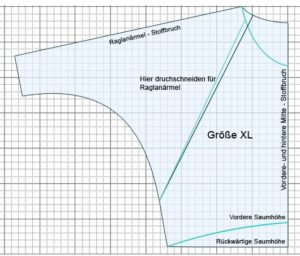
Scheme 4. Oversized sweater pattern
Back
 Knitting women's models always starts from the back, as if the product turns out to be a little smaller. You can always increase the front chest circumference.
Knitting women's models always starts from the back, as if the product turns out to be a little smaller. You can always increase the front chest circumference.
The back pattern is knitted as follows:
- 62 loops are cast on (60 go into the product, 2 edge loops, which are not taken into account when knitting).
- The first row is knitted with an elastic band, alternating the front and back loops. Having reached the end, you need to turn the face over with the wrong side and repeat the row, only now in the opposite direction. This is how you knit 8 rows (if you want the elastic to be wide, then make 15 rows).
- After finishing the elastic, knitting of the main part of the back begins. We knit the front stitch, the result is a garter stitch. Beginners should not focus on the armhole; it is best to make your first sweater a loose fit with the sleeves pulled down.
- Having knitted the main part and reached the shoulders, we proceed to knitting the neckline. To make the neckline, we overlap 25 knit stitches and 30 purl stitches. Then make another 20 loops.
- Having finished knitting the collar, turn the back over and knit another 15 loops (we omit the last 5, we knit 3 according to the pattern).
- We return to the front side again and make 15 loops in a row. The loops close only when the collar reaches 3-5 cm in volume.
- After finishing the main work, close the loops, attach the thread to the edge of the second shoulder and tear the thread off the main yarn.
Before
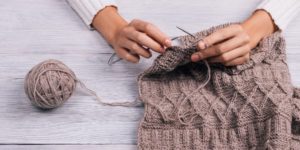 After finishing work on the back, we begin knitting the front part of the product. Here it is worth considering the fact that in women's models the front should be wider (by the volume of the chest).
After finishing work on the back, we begin knitting the front part of the product. Here it is worth considering the fact that in women's models the front should be wider (by the volume of the chest).
The knitting pattern is similar to the back pattern. But there is one feature - you don’t need to tie 6 cm to the edge. The neckline is knitted in exactly the same way as on the back, but taking into account the following details:
- The front neckline is knitted with 29 stitches and overlapped with 13. Then another 20 stitches are knitted with the face.
- Turn the product inside out and knit 20 loops inside out.
- Turn the neck to face and bind off 3 loops. Then we knit another 6 cm of the neckline.
The rest of the face is knitted in the same way as the back.
Important! When calculating the loops for the front part, take into account the chest circumference and how much the product stretches so that the product is not too small.
Sleeves
The oversized sweater is knitted with dropped sleeves. For this model there is no need to make an armhole. Therefore, there is no need to knit the armhole line.
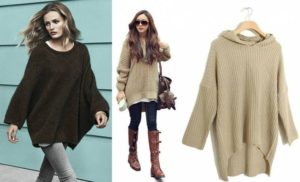 The main feature of this knitting is that at the end of the knitting, the sleeve loops are simply closed. The sleeve is knitted using the following pattern:
The main feature of this knitting is that at the end of the knitting, the sleeve loops are simply closed. The sleeve is knitted using the following pattern:
- 30 loops are cast on and knitted with an elastic band, alternating face and back (8-10 rows).
- Then we proceed to the main knitting. Finishing every 4th row, we increase the number of loops by 2-3 pieces.
- We knit 30-35 rows with the main pattern, depending on the length of the sleeve. Taking into account the addition of loops and the increase in the sleeve, the output should be 40-45 pieces.
- Close the last row and begin knitting the second sleeve.
After finishing the main work, place the two sleeves together. They must be the same in length and width. The same applies to the back and face, only in this case the front part will be slightly larger. After all the parts are ready, we proceed to connecting the future product.
Assembly of finished parts
 When all the parts are there, all that remains is to connect them. For inexperienced craftswomen this will not be difficult.Before joining, it is recommended to pre-moisten the product and wait until it dries completely. Then iron the parts with an iron with a steam function.
When all the parts are there, all that remains is to connect them. For inexperienced craftswomen this will not be difficult.Before joining, it is recommended to pre-moisten the product and wait until it dries completely. Then iron the parts with an iron with a steam function.
We sew the product with threads from yarn. Once the sweater is assembled, you need to try it on. If everything fits in size, you can start tying the neck. It starts from the middle of the back and goes along the entire diameter.
Important! The output should be an even number of loops.
When knitting the neckline, you do not need to remove or add loops. It is enough to knit 7-8 rows alternating face and back. This elastic band is durable and elastic, so it will fit perfectly on the neck and will not stick out.
When knitting, pay attention to the length of the neckline. If you plan to wrap it, then you need to extend it by 8-9 rows. When you want the neck to be to the middle of the neck or lower, then we work on additional rows.
Easy patterns for beginners
The design of an oversized sweater can be very diverse. Which pattern you should choose depends on the experience of the craftswoman. After all, complex patterns may not work out, and as a result, the product will have to be unraveled. The most popular techniques for creating a beautiful pattern on a sweater include:
Facial surface
To create such a pattern, you need to cast on the required number of loops and knit rows, alternating face and back. This is how the entire product is knitted.
 It is more convenient to look at the description of various knitting techniques using the diagram.
It is more convenient to look at the description of various knitting techniques using the diagram.
 Sleeves and neck can also be knitted in stockinette stitch.
Sleeves and neck can also be knitted in stockinette stitch.

Facial surface
Most often, this technique is used to create a base for heavier braid patterns.
Garter stitch
If there is no bright pattern, you should focus on large or bright accessories: pendant, neckerchief, scarf necklace, etc.
 Typically used for knitting sweaters.
Typically used for knitting sweaters.
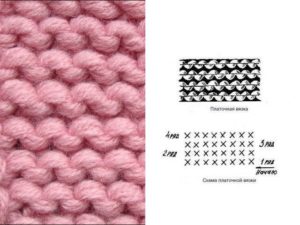
Garter stitch
To make such a pattern, you need to cast on loops and knit all rows with the face.
Braids and plaits
The most popular type of patterns. It can be found on children's, men's and women's sweaters.
 Craftswomen create voluminous, large and small braids. Wavy, straight and intermittent.
Craftswomen create voluminous, large and small braids. Wavy, straight and intermittent.
 With the help of braids, real masterpieces are created. The pattern of the braid will depend on the volume and length of the pattern.
With the help of braids, real masterpieces are created. The pattern of the braid will depend on the volume and length of the pattern.

Scheme 1. Braids

Scheme 2. Complex braids

Scheme 3. Diamonds
Rubber
This technique is usually used to create ribbing on the sleeves and bottom of a sweater.
 There are several variations of the scheme (English, French, etc.). Therefore, each needlewoman will be able to choose her own option.
There are several variations of the scheme (English, French, etc.). Therefore, each needlewoman will be able to choose her own option.

Knitting elastic band.

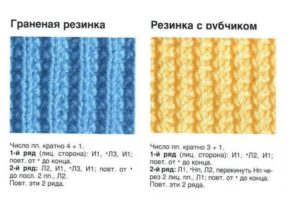
There are a lot of variations of patterns for sweaters. To create an unsurpassed masterpiece, you can knit a sweater in several colors. For example, take neutral pastel shades as a basis, and knit the pattern with bright shades. In addition, the pattern can be made both throughout the sweater and in individual areas (sleeves, throat, bottom or top of the sweater).
Stylish sweater for a girl
You can find many different variations of an oversized sweater on the Internet. There are long, short, voluminous and fitted models. Every fashionista will be able to choose a model to suit her taste or create her own exclusive model.
The most current types of women's sweaters:
 Large neck models. This version of the sweater is knitted from thin threads and resembles a turtleneck. The elongated throat fits tightly to the neck. The entire sweater has a classic cut, half-thigh length.
Large neck models. This version of the sweater is knitted from thin threads and resembles a turtleneck. The elongated throat fits tightly to the neck. The entire sweater has a classic cut, half-thigh length.
 Sweater with large sleeves. This model will help to visually hide external imperfections. Perfect for thin girls, adding volume to the look.For women with wide shoulders, it is better to avoid such sweaters, as they will only enlarge the shoulders, making the image bulky.
Sweater with large sleeves. This model will help to visually hide external imperfections. Perfect for thin girls, adding volume to the look.For women with wide shoulders, it is better to avoid such sweaters, as they will only enlarge the shoulders, making the image bulky.
Products with a voluminous collar. These are very convenient and multifunctional models. A cowl collar can be made as a scarf or head wrap. Will be indispensable in cold weather. Most often, such sweaters have a loose, straight cut and length just below the hip.
 Voluminous sweaters. They are knitted from thick natural yarn. This allows you to make the product fluffy and light. Very often, such oversized sweaters replace outerwear in the autumn season.
Voluminous sweaters. They are knitted from thick natural yarn. This allows you to make the product fluffy and light. Very often, such oversized sweaters replace outerwear in the autumn season.
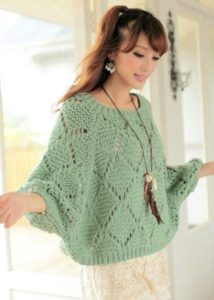 Sweater with 3/4 sleeves. Such models have not lost their relevance for several years. You can wear shirts and blouses under them. Create interesting bows.
Sweater with 3/4 sleeves. Such models have not lost their relevance for several years. You can wear shirts and blouses under them. Create interesting bows.
 V-neck. This neckline elongates the silhouette, making the girl slimmer. Great for ladies with curvy figures.
V-neck. This neckline elongates the silhouette, making the girl slimmer. Great for ladies with curvy figures.
 Sweater with a short front and long back. These product options appeared not so long ago. Initially, this cut was made only in blouses. After which such sweaters appeared, and now there are outerwear with a shortened front. The model is very practical and looks stylish with various clothes and shoes.
Sweater with a short front and long back. These product options appeared not so long ago. Initially, this cut was made only in blouses. After which such sweaters appeared, and now there are outerwear with a shortened front. The model is very practical and looks stylish with various clothes and shoes.
 Knitting a sweater is not that difficult. The main desire of the craftswoman is the desire and focus on results. Before you start knitting, you need to carefully familiarize yourself with all the features of knitting such a sweater. Then choose the appropriate model and material for creating clothes. Taking into account your knowledge, skills and abilities, you can begin to create a masterpiece. The main thing in this matter is patience, and then everything will work out!
Knitting a sweater is not that difficult. The main desire of the craftswoman is the desire and focus on results. Before you start knitting, you need to carefully familiarize yourself with all the features of knitting such a sweater. Then choose the appropriate model and material for creating clothes. Taking into account your knowledge, skills and abilities, you can begin to create a masterpiece. The main thing in this matter is patience, and then everything will work out!


 0
0






Hello! I’m “sick” of your “oversized” sweaters - A sweater with a short front and an elongated back. - Where can I find a description for them Thanks for the ideas! Love
Hello) I also wanted to ask for a link to the description, if there is one. If not, how can we communicate with you and, if possible, resolve the issues. Sincerely, Irina.
Anna, good evening! Tell me which pattern to use for knitting an oversized jumper made of mohair 44-46 with a collar and long sleeves. Thank you Zaragea!
We will do amazing work for you! but still not before, but before...
I'm a beginner, I almost knitted the back. I wanted to read how to make a neckline. I DID NOT UNDERSTAND ANYTHING in your article about the neck. Well, not a word.